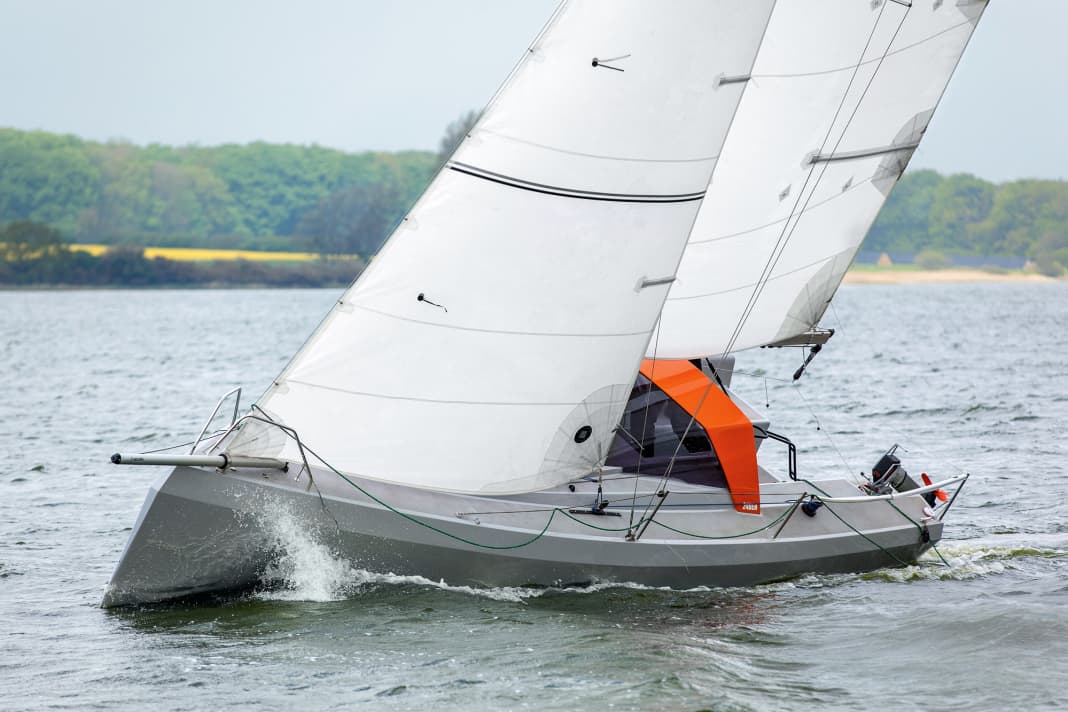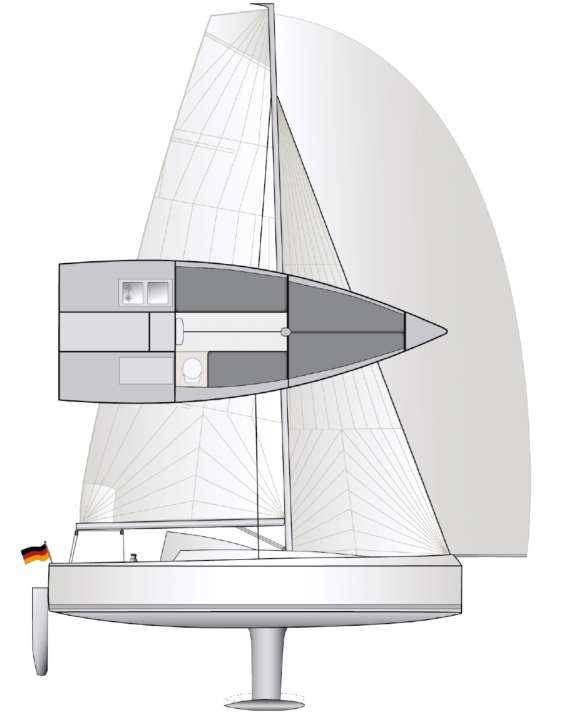Bente 24 in the YACHT test: Striking small cruiser by sailors for sailors






The team was not lacking in self-confidence. "We're saving the world" was the slogan on the website, or more concretely and possibly easier to realise: "Specification: a 24-foot small cruiser. Innovative, affordable and sexy." Stephan "Digger" Boden from Hamburg, an advertising film maker and author, had repeatedly dedicated his blog at the time to the idea of a new boat for young sailors - one that would make sailing attractive and cool again for the next generation of owners. He developed the idea further on his website, on Facebook and in forums.
The idea gets rolling
By chance, contact was made with the circumnavigator Professor Michael Adlkofer from Hanover, who subsequently had 18 product design students develop ideas and concepts. The result was a momentum that continues to this day. Boden met designer Alexander Vrolijk, a designer at Judel/Vrolijk. The two decided to work together and concretised their ideas. More and more partners climbed aboard the as yet non-existent boat: outfitters, sailmakers, material suppliers. At trade fairs, they drummed up, discussed and fabulated. Every visitor was allowed to have their say, give their opinions and feedback, and felt taken seriously and included. Boden and Vrolijk invested their own time in the open source project with admirable energy and were rewarded with a growing wave of sympathy.
Which then also attracted envy. Opponents criticised the fact that other shipyards would not receive this support from the industry or trade fairs, and even spoke of distortion of competition. A manufacturer could not be found at first, large shipyards shied away from small boats, a supposed contradiction, but in any case a fact. Then the Polish shipyard Yachtservice from Szczecin approached Boden and Vrolijk of its own accord and produced a prototype from the mock-up exhibited at the Hanseboot at the time and built by supplier von der Linden. From the initial idea to the first test, the young group had already spent more time on presentations and marketing than many a large shipyard had spent on a new development.
Prototype for further development
For the 2015 tests on the Schlei, the Bente 24 (named after the wife of co-designer Jan Kuhnert, who always demanded a female perspective in the design) is stationed in front of the Arnisser Segel-Club in Kappeln on the Schlei. Tools and pieces of equipment are piled up on the jetty; the team is obviously not quite there yet. Stephan Boden is quick to rebut: "This is a real prototype, we're testing it ourselves. The boat is still too heavy, it could do with more cloth and the rudder blade needs pre-balancing." Alexander Vroloijk adds: "We collect all the opinions and impressions, sort them out and then incorporate the feedback into the series as far as possible."
But the basic concept is set for 2015 and the boat provokes a clear opinion; it polarises, just like the entire project. With chines running from stern to bow and a chamfered transition from hull to deck, it has a very masculine, almost martial appearance, enhanced by the armoured grey colour. Vrolijk: "The chines are not just for looks, the kinks also strengthen the hull, without them we would have had to stiffen the inside more." The negative stem with the deck set further back and the open, wide stern also have a powerful effect.
Dodger the Bente 24 is character-building
However, the outstanding feature in the literal sense of the word is the so-called dodger, a transparent polycarbonate canopy installed over the companionway. Similar to a fixed sprayhood, the part protects the interior and the crew from water ingress. However, the striking piece extends less aft than a spray hood and is less effective than the latter, as it turns out. It is therefore to be revised.
In any case, the dodger brings height to the ship, here you can still stand upright at 1.84 metres and enjoy sheltered harbour cinema in bad weather; otherwise the interior height is only a comfortable 1.45 metres. There are no other lookout options; there are no hull windows or viewing slits in the flat superstructure. Nevertheless, the large companionway, two cockpit windows and the fact that there are virtually no fittings below make the interior light and airy.
Back to the top. Unlike the vast majority of small cruisers, Bente is a boat by and for sailors, as is clear from the flat hull, the high backstayless rig with simple, 27-degree swept spreaders and the spacious cockpit. Vrolijk junior confirms: "The boat is designed from the outside in, not the other way round." Hull lines and dimensions are based on sailing requirements, not on space and comfort considerations. This is also reflected in the deck layout in a style of outfitting that used to be described as French, but has since become established internationally. In other words: lots of ropes instead of metal shackles, a flying triangle made of open Dyneema loops replaces the traveller, aluminium thimbles take the place of pulley blocks. The aim: to save parts, material, weight and, if possible, money.
Varied density in the 24-foot class: the competition of the Bente 24
- Beneteau First 24 SE: Small cruiser with excessive sailing potential in the test
- Flaar 24 on test: carbon fibre small cruiser enriches the small boat segment
- Pointer 25: Honest all-rounder from Holland
- Saffier SE 24 Lite: Poison green daysailer from Holland put to the test
- Maxus 24 Evo: Campervan for cruising
Large selection
With the help of the optional electric whisk from Torqeedo and line support, we push the Bente out of the harbour against the inward current. Shortly afterwards, the engine does the GDL-Weselsky; strike, no more juice; apparently the charging cable was not connected properly overnight. However, Stephan Boden hopes that the system will deliver a cruising speed of 4.5 knots for just under five hours. In addition to the more expensive electric motor, the boat is also offered with a petrol outboard motor; an inboard motor is not listed. However, they are working on a retractable Torqeedo, which will be flush with a hull plate when extended and raised.
Sail up. A little more friction is noticeable than with the deflection blocks, but this is still acceptable. The standard Dacron cloths from Lee Sails have been used. As it turns out, they still offer upward potential in terms of stability. There will also be crusing sails from Doyle. The team also offers higher-quality membrane sets from Banks or Doyle with more surface area in both sails and fathead sizes, as well as moderate laminate cloths that lie between the cruising and racing products. But even with simple goods: the boat sails as it should at around 3 to 4 Beaufort. Swift, agile, around six knots of speed and more can be achieved on the cross, but then with compromises in terms of height.
Sailing performance meets the needs of the target group
With the best VMG, the turning angles are just under 90 degrees. The rudder angle of around three degrees is ideal, so the rudder pressure should be right. However, it is not, as the blade is not pre-balanced enough. In other words, the effort required to steer is still too great. The problem has been solved. Nice: The boat can handle pressure and position. In the gusts or with a provoked oversized heel, it packs away, but does not shoot into the wind even at around 30 degrees or more. This only happens under gennaker with even more heel and a gennaker that closes too much in the leeward leech. The behaviour matches the calculated stability. The maximum righting moment is generated at 70 degrees; the stability increases continuously in the lever arm curve.
The boat sails fast, but not poisonously, so it does justice to the target group. The deck layout works. The jib sheets, which are set at a 1:2 ratio, can be tightened with little effort by pulling on the winches. The height of the mainsheet foot block is variable thanks to the open splices of the line triangle, allowing the boom to be pulled to windward in light winds so as not to close the sail too much at the top. The sheet ends at the boom and is driven from above like on modern planing dinghies. This is ergonomically sensible and also works quite well when sailing out to sea.
Under gennaker, the boat sets off refreshingly, wants to and quickly gets planing: On the test day, the Bente 24 logged over ten knots. Weighing in at around 1.5 tonnes and with around 74 square metres of cloth on the beam, she is in the mid-range of small sporty yachts, which is a good fit. So everything is fine underway except for the rudder? Not yet. In the 2015 test, there were no foot rails on deck, nor any support for the feet when the helmsman sits on the beautifully bevelled coaming.
Boat sails, is fun, all good
Due to the system, the dodger has a small shortcoming in terms of handling: the gennaker is more difficult to hoist in the companionway because it has to be hoisted round the corner. Of course, the cloth can also be recovered through the fore hatch, but this is hardly suitable for small crews or even single-handed sailing. Vrolijk: "In future, we want to mount the dodger so that it can be dismantled quickly for regattas." With or without a canopy: the boat sails, it's fun, it's all good.
Thanks to the dodger, the cockpit also offers simple connection options for a cake stand and plenty of additional living space with 2.20 metre long dents. The fixed sprayhood could also be seen as a symbol of the spiritual neighbourhood to Dehler's similarly designed Little Red Riding Hood. This is the predecessor of Boden's Varianta 18, also designed by Judel/Vrolijk and at the time fitted with a red companionway canopy that gave it its name.
Back to the facts: The companionway is cut out asymmetrically, which provides more air below deck and steam from the galley. It is located on the port side and can be moved in good old small cruiser style. Opposite, very Bente-esque, is a tiny toilet room, sealed off only by canvas, which can be equipped with a chemical or pump toilet.
Otherwise, the interior is open and generously proportioned, with storage space mainly under the bunks and in pockets velcroed to the inside walls. Standing is not possible, but sitting is fine. There is also plenty of headroom on the forward berth, which is also large, no, generous, with a width of 1.70 metres. There is also a saloon berth, a sofa opposite and two aft berths. However, depending on the equipment option selected, the space under the cockpit thwarts is partially used for the sliding pantry or as a forecastle.
Close to the goal
It sails, it's somehow cool, it has something. Boden and Judel/Vrolijk & Co. did not reinvent the deep plate or the sandwich. But their baby enriched the market, without a doubt. The variable, modern and stylish performance cruiser from a renowned design office at the price of a mid-range car did not exist at the time, apart from perhaps the failed SQ 25. A fact, regardless of your personal attitude to the hype surrounding the project.
In 2020, the company got into difficulties and insolvency proceedings were applied for at Bremerhaven District Court. Just a few weeks later, the company Ultramarin Meichle & Mohr in Kressbronn on Lake Constance acquired Benteyachts and is still on the market with models 24, 28 and 29.
The measured values for the Bente 24 test





The Bente 24 in detail

Technical data of the Bente 24
- Designer: Judel/Vrolijk & Co.
- CE design category: C, opt. B
- Torso length: 7,55 m
- Waterline length: 7,15 m
- Width: 2,75 m
- Draught/alternative: 1,45/1,80 m
- Theoretical torso speed: 6.5 kn
- Weight: from 1.6 tonnes
- Ballast/proportion: 0,5 t/40 %
- Mast height above WL/Opt: 11,15/11,90 m
- Machine (petrol AB.): 3.73 kW/5 hp
- Machine (electric AB.): Torqeedo 2.0
Hull and deck construction
Hull and deck GRP sandwich with foam core, hand lay-up method. Bulkheads and deck-hull connection glued. Cast iron keel fin, lead bomb. Collision bulkhead
Price and shipyard
- Base price ex shipyard: 75,595 € gross incl. 19% VAT.
- Guarantee/against osmosis: 2/5 years
Status 03/2024
Shipyard
Yachtservice, Szczecin/Poland; www.yachtservice.com.pl
Distribution
Judel/Vrolijk Brokerage, 27568 Bremerhaven, Tel. 0471/308811-0; www.judel-vrolijk.com/brokerage
YACHT review of the Bente 24
A fresh, albeit polarising look, good options for fittings, keels and sails, a fair price: the Bente 24 does what it is supposed to do. However, the tested prototype did not yet allow any final statements to be made regarding the finish and build quality, and the weight will also differ in series production
Design and concept
- + Modern, fresh design
- + Selectable sail areas and keels
- + Favourable base price
Sailing performance and trim
- + High potential
- + Lubricity
- + Good deck layout with options
Living and finishing quality
- + Plenty of space and berths
- + Large cockpit
- - Little storage space inside
Equipment and technology
- + Largely high-quality accessories
- + WC room on request
- + Dodger as standard
The Bente 24 in video
The article first appeared in YACHT 13/2015 and has been updated for the online version.
More YACHT tests:
- Flaar 24 on test: carbon fibre small cruiser enriches the small boat segment
- RM 1380: Sporty tourer with a focus on blue water cruising
- Esse 330 in the test: Weekender harmonises powerful performance and comfort
- Pure 42 DS: New aluminium deck saloon yacht
- Grand Soleil 42 LC: Convertible all-rounder in the YACHT test


